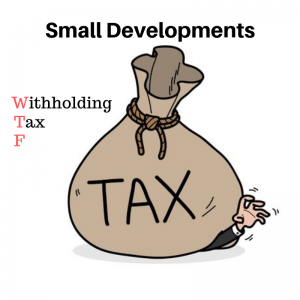
Small Developers
If your project includes actually constructing a building with the intention of selling for a profit then you must charge GST when you sell. Make sure to ask about a margin scheme clause in the contract to reduce your GST. The same applies if you buy land with the intention of subdividing and selling off the lots.
This article is specifically directed at small developers who may be able to avoid having to charge GST when they sell. An example would be cutting a couple of lots off a home block. This article discusses how to now deal with the new requirements relating to when the purchaser is required to withhold the GST at settlement and send it straight to the ATO on the seller’s behalf.
The ATO have finalised their ruling on the matter LCR 2018/4
https://www.ato.gov.au/law/view/document?LocID=%22COG%2FLCR20184%2FNAT%2FATO%22&PiT=99991231235958
The relevant legislation is section 14 of the Tax Administration Act 1953 and it does not provide a method by which this GST can be refunded unless you lodge a BAS. You cannot lodge a BAS if you are not registered for GST and if your register for GST the game is up and you do have to charge GST after all.
So back to how you can subdivide land and sell it off without having to pay GST. It is a question of whether you are merely realising an asset or in the business of selling blocks of land. In the latter case the blocks would be part of your business turnover.
If you are not already registered for GST you are not required to do so just because you choose to merely realise an asset. Section 23-5 of the GST Act states that if the annual turnover of supplies you make in the normal course of your enterprise, exceed $75,000 you must register for GST. Section 185-25 excludes from the calculation of annual turnover the supply of a capital asset.
Vacant land would normally be subject to GST whether it is a capital asset or trading stock but only in the case where the owner is registered or required to be registered for GST. If you don’t have any other business interests that require you to register for GST then merely realising an asset, even if it is worth more than $75,000, won’t force you to register.
The question of whether you are merely realising an asset is so important we have written a whole booklet about it https://www.bantacs.com.au/booklets/How-Not-to-Bea-a-Developer-Booklet.pdf An example would be subdividing a property you have held for many years for a purpose other than development. You only do the bare minimum works necessary to gain council approval. You do very little of the work yourself and apparently it is important that you get a real estate agent to sell the blocks.
If this all seems a little onerous consider that you will get the same price for the block of land anyway it is just a question of whether you give 1/11th of that to the ATO. If that has got your interest please read further to get into the nitty gritty of the new hurdle the ATO have thrown in your way with this withholding obligation imposed on purchasers.
So having got this far we are now only discussing the sale of vacant land that you did not originally purchase with the intention of subdividing. If this vacant land has potential to be used for residential purposes and is included in a property subdivision plan, then it is caught by the act, reference section 14-250 1953 TAA. Note this can even include a farm or land intended for commercial use if the zoning would allow a house to be built, according to paragraph 26 of LCR 2018/4
These new withholding laws put the onus on the purchaser to withhold 1/11th of the purchase price at settlement and send it to the ATO. You do not want this to happen as it appears you are going to have trouble getting it back.
LCR 2018/4 states
- The vendor is then entitled to a credit for the amount paid to the Commissioner by the purchaser. The credit arises when the vendor’s net amount is assessed on their GST return.
The loop hole you need to utilise is in paragraph 15 of LCR 2018/4
- A purchaser only has a GST withholding obligation when a vendor is making a taxable supply. A vendor will not be making a taxable supply in situations including:
where the vendor is not registered for GST and not required to be registered for GST as the sale is not in the course or furtherance of an enterprise
Which brings us back to section 23-5 and 185-25 of the GST Act referred to earlier.
The withholding laws require, you, the vendor/seller to provide the purchaser with a notice setting out their obligations. This is explained at paragraphs 58 to 62 ,of LCR 2018/4, of particular interest to you is paragraph 59
- This requirement applies to all vendors of residential premises and potential residential land, not only those who are registered or required to be registered for GST. If the vendor is not registered or required to be registered for GST, they simply state that the purchaser is not required to make a payment.
So there you go that is your out. Give the purchaser notice that you are not required to be registered for GST because you are merely realising an asset and they should not withhold.
The trouble is the law makes the purchaser liable to pay the GST even if they don’t withhold if it was reasonable to assume you should have been registered for GST. I see a lot of problems here with solicitors getting anxious and settlements being delayed.
Further, you have got to ask that, if this legislation is intended to catch phoenix operators who take off with the sale proceeds before paying the GST, what makes the ATO think that they wouldn’t also lie about whether they are required to be registered?
I wouldn’t blame a solicitor for anticipating that this legislation is going to be used more for catching the purchaser out than catching out the vendor.
The point here is it would be prudent to anticipate trouble, the only way of really putting your purchaser’s solicitor’s mind at rest is to have an ATO ruling that you are not required to be registered for GST. Now these rulings are only supposed to take 28 days but my experience is they take several months. So your choices are:
Draw attention to yourself by applying for a ruling long before you are ready to sell. If your buyer’s solicitor is not over protective this might not have been necessary.
or
Wait and see if the buyer’s solicitor asks questions and risk losing the sale while you wait for a response to your ruling application.
There is another advantage in applying for a ruling. If it comes back against you, that is you are found to be doing more than merely realising an asset, at least you have the opportunity to put a margin scheme clause in the contract. This is always the risk a small developer takes by assuming that the ATO will accept that they are merely realising an asset. You see if the ATO come along later and decide GST should have applied anyway, they are going to want a whole 1/11th of the selling price and it may be too late to claim back the GST on your development costs. It may also be too late to get the buyer to agree to the margin scheme. The margin scheme applies if you were not entitled to claim a GST input credit when you purchased the property. It allows you to only have to pay GST of 1/11th on the difference (margin) between the price you paid and the selling price.
The prudent solution is to get an ATO ruling right from the start and accept if it comes back that GST applies you can utilise the margin scheme. Further, if it comes back in your favour you have a document that will ensure you do not experience any delays at settlement. Best of all you can sleep well at night.
Footnote: If you are a buyer this is the paragraph from LCR 2018/4 that you have to worry about when deciding if you will simply accept a statement made by the seller that there is no need to withhold.
- The penalty for failure to pay the GST withholding amount does not apply if:
the purchaser received a taxable supply of new residential premises (other than commercial residential premises)
the purchaser was given a notice either[34]
–
stating that the premises are not new residential premises, or
–
indicating that they were not required to pay an amount under section 14-250 for the supply
at the time the purchaser first provides consideration for the supply, there was nothing in the contract for the supply or any other circumstances relating to the supply that made it unreasonable for the purchaser to believe that the statement or indication was correct.[35]
Interestingly, this paragraph does not talk about vacant land. In a discussion with the ATO on this I was told they would still expect the purchaser to withhold no matter what the notice from the seller said if the seller was an entity other than an individual. Or if the block was one of a group of blocks but would not be drawn into how many make a group. I think it is quite unfair that they have this policy but do not state it anywhere in the ruling.
 Julia's Blog
Julia's Blog